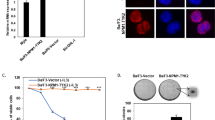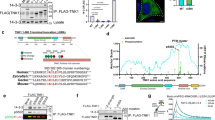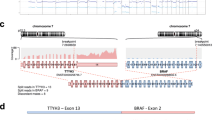Abstract
The NUP214-ABL1 fusion kinase has recently been identified in 6% of patients with T-cell acute lymphoblastic leukemia. In contrast to the more common oncogenic ABL1 fusion BCR-ABL1, NUP214-ABL1 localizes to the nuclear pore complexes and has attenuated transforming properties in hematopoietic cells and in mouse bone marrow transplant models. We have performed a thorough biochemical comparative analysis of NUP214-ABL1 and BCR-ABL1 and show that, despite their common tyrosine kinase domain, the two fusion proteins differ in many critical catalytic properties. NUP214-ABL1 has lower in vitro tyrosine kinase activity, which is in agreement with the absence of phosphorylation on its activation loop. NUP214-ABL1 was more sensitive to imatinib (Glivec) than BCR-ABL1 in vitro and in cells, indicating a different activation state and conformation of the two ABL1 fusion kinases. Using a peptide array, we identified differences in the spectrum and efficiency of substrate peptide phosphorylation and a differential involvement of Src kinases in downstream signaling. These results clearly indicate that different fusion partners of the same kinase can determine not only localization, but also critical functional properties of the enzyme such as inhibitor sensitivity and substrate preference, with subsequent differences in downstream signaling effectors and likely consequences in disease pathogenesis.
This is a preview of subscription content, access via your institution
Access options
Subscribe to this journal
Receive 12 print issues and online access
$259.00 per year
only $21.58 per issue
Buy this article
- Purchase on Springer Link
- Instant access to full article PDF
Prices may be subject to local taxes which are calculated during checkout





Similar content being viewed by others
References
Hubbard SR . Protein tyrosine kinases: autoregulation and small-molecule inhibition. Curr Opin Struct Biol 2002; 12: 735–741.
Rikova K, Guo A, Zeng Q, Possemato A, Yu J, Haack H et al. Global survey of phosphotyrosine signaling identifies oncogenic kinases in lung cancer. Cell 2007; 131: 1190–1203.
Huse M, Kuriyan J . The conformational plasticity of protein kinases. Cell 2002; 109: 275–282.
Hantschel O, Superti-Furga G . Regulation of the c-Abl and Bcr-Abl tyrosine kinases. Nat Rev Mol Cell Biol 2004; 5: 33–44.
Cross NC, Reiter A . Tyrosine kinase fusion genes in chronic myeloproliferative diseases. Leukemia 2002; 16: 1207–1212.
De Keersmaecker K, Cools J . Chronic myeloproliferative disorders: a tyrosine kinase tale. Leukemia 2006; 20: 200–205.
Wong S, Witte ON . The BCR-ABL Story: bench to bedside and back. Annu Rev Immunol 2004; 22: 247–306.
Daley GQ, Van Etten RA, Baltimore D . Induction of chronic myelogenous leukemia in mice by the P210bcr/abl gene of the Philadelphia chromosome. Science 1990; 247: 824–830.
Li S, Ilaria Jr RL, Million RP, Daley GQ, Van Etten RA . The P190, P210 and P230 forms of the BCR/ABL oncogene induce a similar chronic myeloid leukemia-like syndrome in mice but have different lymphoid leukemogenic activity. J Exp Med 1999; 189: 1399–1412.
Huettner CS, Zhang P, Van Etten RA, Tenen DG . Reversibility of acute B-cell leukaemia induced by BCR-ABL1. Nat Genet 2000; 24: 57–60.
Van Etten RA . Oncogenic signaling: new insights and controversies from chronic myeloid leukemia. J Exp Med 2007; 204: 461–465.
McWhirter JR, Galasso DL, Wang JY . A coiled-coil oligomerization domain of Bcr is essential for the transforming function of Bcr-Abl oncoproteins. Mol Cell Biol 1993; 13: 7587–7595.
Hantschel O, Nagar B, Guettler S, Kretzschmar J, Dorey K, Kuriyan J et al. A myristoyl/phosphotyrosine switch regulates c-Abl. Cell 2003; 112: 845–857.
Pendergast AM, Quilliam LA, Cripe LD, Bassing CH, Dai Z, Li N et al. BCR-ABL-induced oncogenesis is mediated by direct interaction with the SH2 domain of the GRB-2 adaptor protein. Cell 1993; 75: 175–185.
Million RP, Harakawa N, Roumiantsev S, Varticovski L, Van Etten RA . A direct binding site for Grb2 contributes to transformation and leukemogenesis by the Tel-Abl (ETV6-Abl) tyrosine kinase. Mol Cell Biol 2004; 24: 4685–4695.
Deininger M, Buchdunger E, Druker BJ . The development of imatinib as a therapeutic agent for chronic myeloid leukemia. Blood 2005; 105: 2640–2653.
Weisberg E, Manley P, Mestan J, Cowan-Jacob S, Ray A, Griffin JD . AMN107 (nilotinib): a novel and selective inhibitor of BCR-ABL. Br J Cancer 2006; 94: 1765–1769.
Kantarjian H, Jabbour E, Grimley J, Kirkpatrick P . Dasatinib. Nat Rev Drug Discov 2006; 5: 717–718.
De Keersmaecker K, Graux C, Odero MD, Mentens N, Somers R, Maertens J et al. Fusion of EML1 to ABL1 in T-cell acute lymphoblastic leukemia with cryptic t(9;14)(q34;q32). Blood 2005; 105: 4849–4852.
Graux C, Cools J, Melotte C, Quentmeier H, Ferrando A, Levine R et al. Fusion of NUP214 to ABL1 on amplified episomes in T-cell acute lymphoblastic leukemia. Nat Genet 2004; 36: 1084–1089.
Van Limbergen H, Beverloo HB, van Drunen E, Janssens A, Hahlen K, Poppe B et al. Molecular cytogenetic and clinical findings in ETV6/ABL1-positive leukemia. Genes Chromosomes Cancer 2001; 30: 274–282.
Golub TR, Goga A, Barker GF, Afar DE, McLaughlin J, Bohlander SK et al. Oligomerization of the ABL tyrosine kinase by the Ets protein TEL in human leukemia. Mol Cell Biol 1996; 16: 4107–4116.
Okuda K, Golub TR, Gilliland DG, Griffin JD . p210BCR/ABL, p190BCR/ABL, and TEL/ABL activate similar signal transduction pathways in hematopoietic cell lines. Oncogene 1996; 13: 1147–1152.
De Keersmaecker K, Rocnik JL, Bernad R, Lee BH, Leeman D, Gielen O et al. Kinase activation and transformation by NUP214-ABL1 is dependent on the context of the nuclear pore. Mol Cell 2008; 31: 134–142.
Hantschel O, Wiesner S, Guttler T, Mackereth CD, Rix LL, Mikes Z et al. Structural basis for the cytoskeletal association of Bcr-Abl/c-Abl. Mol Cell 2005; 19: 461–473.
Tauchi T, Miyazawa K, Feng GS, Broxmeyer HE, Toyama K . A coiled-coil tetramerization domain of BCR-ABL is essential for the interactions of SH2-containing signal transduction molecules. J Biol Chem 1997; 272: 1389–1394.
Quintas-Cardama A, Tong W, Manshouri T, Vega F, Lennon PA, Cools J et al. Activity of tyrosine kinase inhibitors against human NUP214-ABL1-positive T cell malignancies. Leukemia 2008; 22: 1117–1124.
Pluk H, Dorey K, Superti-Furga G . Autoinhibition of c-Abl. Cell 2002; 108: 247–259.
Zhou S, Carraway III KL, Eck MJ, Harrison SC, Feldman RA, Mohammadi M et al. Catalytic specificity of protein-tyrosine kinases is critical for selective signalling. Nature 1995; 373: 536–539.
Goss VL, Lee KA, Moritz A, Nardone J, Spek EJ, Macneill J et al. A common phosphotyrosine signature for the Bcr-Abl kinase. Blood 2006; 107: 4888–4897.
Steen H, Fernandez M, Ghaffari S, Pandey A, Mann M . Phosphotyrosine mapping in Bcr/Abl oncoprotein using phosphotyrosine-specific immonium ion scanning. Mol Cell Proteomics 2003; 2: 138–145.
Salomon AR, Ficarro SB, Brill LM, Brinker A, Phung QT, Ericson C et al. Profiling of tyrosine phosphorylation pathways in human cells using mass spectrometry. Proc Natl Acad Sci USA 2003; 100: 443–448.
Brasher BB, Van Etten RA . c-Abl has high intrinsic tyrosine kinase activity that is stimulated by mutation of the src homology 3 domain and by autophosphorylation at two distinct regulatory tyrosines. J Biol Chem 2000; 275: 35631–35637.
Dorey K, Engen JR, Kretzschmar J, Wilm M, Neubauer G, Schindler T et al. Phosphorylation and structure-based functional studies reveal a positive and a negative role for the activation loop of the c-Abl tyrosine kinase. Oncogene 2001; 20: 8075–8084.
Schindler T, Bornmann W, Pellicena P, Miller WT, Clarkson B, Kuriyan J . Structural mechanism for STI-571 inhibition of abelson tyrosine kinase. Science 2000; 289: 1938–1942.
Nagar B, Hantschel O, Young MA, Scheffzek K, Veach D, Bornmann W et al. Structural basis for the autoinhibition of c-Abl tyrosine kinase. Cell 2003; 112: 859–871.
Tokarski JS, Newitt JA, Chang CY, Cheng JD, Wittekind M, Kiefer SE et al. The structure of dasatinib (BMS-354825) bound to activated ABL kinase domain elucidates its inhibitory activity against imatinib-resistant ABL mutants. Cancer Res 2006; 66: 5790–5797.
Vajpai N, Strauss A, Fendrich G, Cowan-Jacob SW, Manley PW, Grzesiek S et al. Solution conformations and dynamics of ABL kinase inhibitor complexes determined by NMR substantiate the different binding modes of imatinib/nilotinib and dasatinib. J Biol Chem 2008; 283: 18292–18302.
Manley PW, Cowan-Jacob SW, Fendrich G, Strauss A, Vapai N, Grzesiek S et al. Bcr-Abl binding modes of dasatinib, imatinib and nilotinib: an NMR study. Blood 2006; 108: 224A.
Danhauser-Riedl S, Warmuth M, Druker BJ, Emmerich B, Hallek M . Activation of Src kinases p53/56lyn and p59hck by p210bcr/abl in myeloid cells. Cancer Res 1996; 56: 3589–3596.
Pecquet C, Nyga R, Penard-Lacronique V, Smithgall TE, Murakami H, Regnier A et al. The Src tyrosine kinase Hck is required for Tel-Abl- but not for Tel-Jak2-induced cell transformation. Oncogene 2007; 26: 1577–1585.
Hantschel O, Rix U, Schmidt U, Burckstummer T, Kneidinger M, Schutze G et al. The Btk tyrosine kinase is a major target of the Bcr-Abl inhibitor dasatinib. Proc Natl Acad Sci USA 2007; 104: 13283–13288.
Rix U, Hantschel O, Durnberger G, Remsing Rix LL, Planyavsky M, Fernbach NV et al. Chemical proteomic profiles of the BCR-ABL inhibitors imatinib, nilotinib and dasatinib reveal novel kinase and non-kinase targets. Blood 2007; 110: 4055–4063.
Bantscheff M, Eberhard D, Abraham Y, Bastuck S, Boesche M, Hobson S et al. Quantitative chemical proteomics reveals mechanisms of action of clinical ABL kinase inhibitors. Nat Biotechnol 2007; 25: 1035–1044.
Songyang Z, Blechner S, Hoagland N, Hoekstra MF, Piwnica-Worms H, Cantley LC . Use of an oriented peptide library to determine the optimal substrates of protein kinases. Curr Biol 1994; 4: 973–982.
Zhou S, Cantley LC . Recognition and specificity in protein tyrosine kinase-mediated signalling. Trends Biochem Sci 1995; 20: 470–475.
Grossmann AH, Kolibaba KS, Willis SG, Corbin AS, Langdon WS, Deininger MW et al. Catalytic domains of tyrosine kinases determine the phosphorylation sites within c-Cbl. FEBS Lett 2004; 577: 555–562.
Acknowledgements
We thank Ines Kaupe for expert technical assistance, Tilmann Buerckstuemmer, Christoph Baumann and Florian Grebien for the critical reading of the manuscript and all members of the Cools and Superti-Furga lab for help and discussions. KDK is an ‘Aspirant’ researcher of the FWO-Vlaanderen. This work was supported by the Austrian Academy of Sciences, the FWF (Grant no. P18737-B11), AICR, EACR and Research Grant of the Fund for Scientific Research—Flanders (Belgium).
Author information
Authors and Affiliations
Corresponding author
Additional information
Supplementary Information accompanies the paper on the Leukemia website (http://www.nature.com/leu)
Supplementary information
Rights and permissions
About this article
Cite this article
De Keersmaecker, K., Versele, M., Cools, J. et al. Intrinsic differences between the catalytic properties of the oncogenic NUP214-ABL1 and BCR-ABL1 fusion protein kinases. Leukemia 22, 2208–2216 (2008). https://doi.org/10.1038/leu.2008.242
Received:
Revised:
Accepted:
Published:
Issue Date:
DOI: https://doi.org/10.1038/leu.2008.242
Keywords
This article is cited by
-
Unique amplification of BCR-ABL1 gene fusion in a case of T-cell acute lymphoblastic leukemia
Molecular Cytogenetics (2017)
-
Differential signaling networks of Bcr–Abl p210 and p190 kinases in leukemia cells defined by functional proteomics
Leukemia (2017)
-
Deciphering Enzyme Function Using Peptide Arrays
Molecular Biotechnology (2011)
-
Rapid complete cytogenetic remission after upfront dasatinib monotherapy in a patient with a NUP214-ABL1-positive T-cell acute lymphoblastic leukemia
Leukemia (2009)



